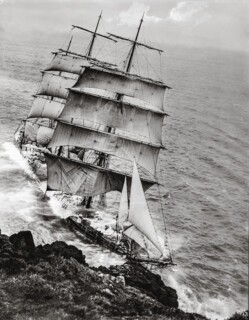John Gibson was born in 1827 in rural Ireland. He went to sea at the age of twelve – the family were poor – but at 34 settled as a grocer in St Mary’s, the largest of the Scilly Isles. His business grew, and in 1870 he opened a photographic portrait studio attached to the shop. He had taken a course in Plymouth and was now equipped to shoot the people of the isles. His son Alexander picked up photography as a boy. He also took an interest in geology and folklore, and in the fauna and flora of the islands. The first telegraph cable connecting the Scilly Isles to mainland Britain arrived in 1870, and John became the local editor for a newspaper, filing reports along the new cable under the sea. He had already photographed shipwrecks when the German steamship Schiller sank off the skerry known as Bishop Rock in 1875. More than three hundred men died, not far from shore. He wrote many articles about the disaster. His son Alexander went further: when the Aksai, a Russian steamer, was wrecked on White Island later that year, he went out in a small boat, in a November gale, taking his large-format camera and several lenses as well as two heavy, fragile, expensive glass plates. The plates had to be kept wet and unmussed until they could be developed in the darkroom. Alexander’s daring became business for the family. Postcards of shipwrecks, as well as more orthodox views of landscapes and buildings, sold well in the summer months. His brother and four sisters all assisted. His son, James, followed, then James’s son, Frank. Fathers and sons fell out, but the shipwreck pictures continued – until they didn’t. There have been only two shipwrecks off the isles since 1979. The last one included in Shipwreck, Carl Douglas and Björn Hagberg’s selection from the family archive (Max Ström, £35), is the Jeanne Gougy, a French trawler from Dieppe that sank in 1962. It’s a beautiful photograph. A huge white wave crashes over the crescent-moon hull of the boat, which lies on its side, defeated. There is something to see in each picture – the rigging, the rocks, the crowds, the crews. The wreckage and the rescue. The vast structures built by men and the vaster arm of the sea. This is the Norwegian barque Gunvor, sunk in 1912, with no loss of life – except for the ship’s cat.
Send Letters To:
The Editor
London Review of Books,
28 Little Russell Street
London, WC1A 2HN
letters@lrb.co.uk
Please include name, address, and a telephone number.


